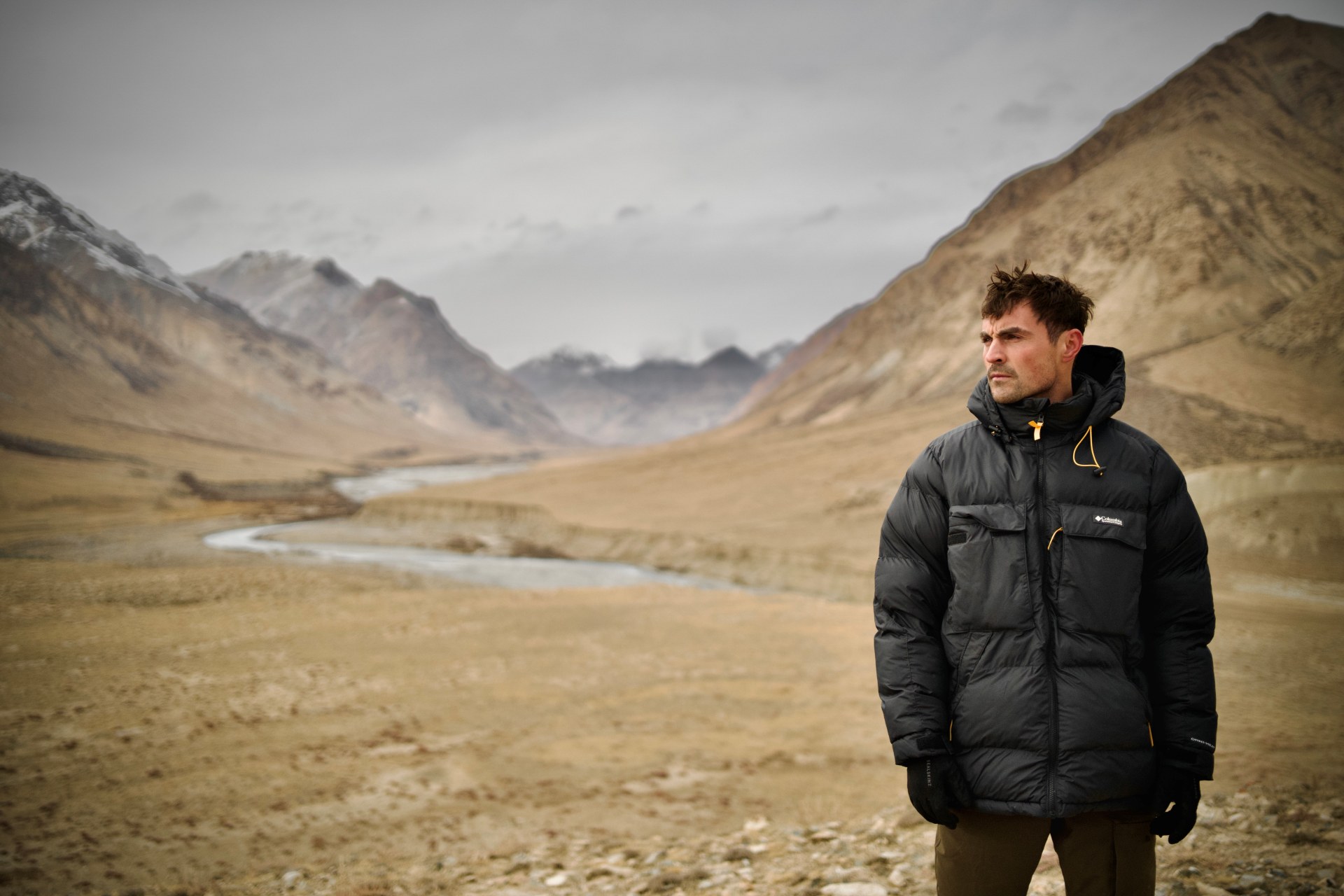Biologist Dan O’Neill: ‘Could we be the first species to end a mass extinction?’ (EXCLUSIVE)
In his new series Snow Leopards with Dan O'Neill, the wildlife presenter, leader of the STEM category of the 2025 Attitude 101, empowered by Bentley, tracks the Gobi Desert's most elusive predator.
By Dan O'Neill

Biologist Dan O’Neill became the first publicly LGBTQ+ television presenter to host a wildlife series with his 2023 series Giants. Here, the leader of the STEM category of Attitude 101, empowered by Bentley (see here for the full list of the 10 influential figures who made the 2025 Attitude 101 STEM list). he describes the adrenaline rush of tracking snow leopards through the Gobi Desert for his latest series.
Bleak, unthinkably vast, yet undeniably beautiful, Mongolia’s Gobi Desert is the kind of place that forces you to confront the fact that you are, potentially, totally insignificant. It is a fact that is both unnerving and oddly comforting. The Gobi Desert holds a rare kind of wonder: it acts as a reflection. It compels you to look back at yourself and question your role on this incredible planet, to consider what it is to be human, and how we are — or are not — upholding and adding value to something incredibly remarkable.
It was here, during the spring field season of 2024, in one of Earth’s harshest environments, that our team studied a famously camouflaged and impossibly elusive predator: the snow leopard. The rugged mountains and endless steppe landscapes — not dissimilar to the surface of Mars or, to offer a more relatable comparison, the set of the film Dune — are home to the largest population of these vulnerable big cats outside China. Our mission: to fit them with GPS tracking collars. This data would contribute to the longest-running ecological study of snow leopards in history.
We knew that we would need to exercise patience to be in with a shot of undertaking such a mammoth task, and the idea of capturing something so rare started to feel like chasing a shadow. But after an entire week of waiting, sat in sub-zero temperatures wondering if the 15 tiny traps we had scattered across the vast mountain range were no more than a fool’s hope, the alarm finally fired, waking the team and I, a group of international and local scientists from the Snow Leopard Trust, with a jolt in the middle of night.
It is no understatement to say that my body felt like it was going to ignite from the adrenaline. I could almost taste a metallic euphoria pumping through my blood as we raced through the darkness on our quad bikes. We couldn’t be certain (certainty is not something that you find in abundance in the Gobi Desert), but at this time of night, it was unlikely to be anything else.
As we approached the edge of a valley, the Snow Leopard Trust’s senior scientists Örjan Johansson and Gustaf Samelius signalled for us to stop. We kicked our engines off and allowed the silence to envelop us. The air stilled. We hardly dared to breathe as we watched Örjan and Gustaf move with utter precision as they loaded the dart gun, proceeded down the verge, and disappeared into the blackness.
We waited, listening.
Then it came: the confirmation.
Örjan and Gustaf returned to us — with thumbs up. A wave of relief rippled through the team. We had seven minutes. Seven more minutes of quiet until the sedative would take hold, and our work would begin. Against all odds, we had done it. Somewhere out ahead of us in the dark, we were about to come face to face with our elusive ghost.
Once the snow leopard had been darted, we were on the clock. Less than an hour to take blood samples, record measurements and fit the GPS collar before the sedative wore off and the cat disappeared back into the mountains. During this incredibly high-stakes process, the team moved like a well-oiled machine. I barely had a chance to take in just how ridiculous — and deeply humbling — it was to be in this situation while monitoring the cat’s heart rate and temperature.
Meeting these magical creatures, these ghosts that haunt the mountains of the Gobi, was an experience that will live with me forever.
Over the course of the entire field season, we successfully collared three more adult snow leopards, each one destined to bring new revelations about the movements, hunting habits and interactions of this little-understood species. The data collected from the study doesn’t just fill gaps in our zoological knowledge; it shapes how we approach conservation. From guiding community projects to redefining protected area boundaries, every bit of information offers a thread of hope for a species that once seemed set for extinction.
The Snow Leopard Conservation Foundation’s work in the Gobi, led by executive director Pujii Lkhagvajav, in partnership with the Snow Leopard Trust, has become a blueprint for ethical conservation success. In all 12 snow leopard range countries, herders face economic hardship when their livestock is taken by predators. The Snow Leopard Trust’s innovative programmes — from livestock insurance schemes to creating alternative income opportunities for local women — have turned potential conflict into collaboration. These programmes protect snow leopards by creating a sense of shared responsibility for the land and its wildlife that prioritises people rather than excludes them. It’s not every day you see a community celebrating the very predators that once raided their flocks, but that’s the magic of a well-executed conservation initiative. Some local herders — including Buren Nyam — who have suffered many losses over the years due to the cats, are now critical members of the team, working as field rangers and ambassadors of snow leopard conservation.
The GPS collaring project has revealed some fascinating secrets in recent years. Snow leopards have been observed traversing hundreds of kilometres across open steppes in search of new territories, expanding our understanding of their dispersal. One particularly intrepid cat, which the team affectionately nicknamed ‘the wanderer’, attempted to cross a huge distance between two mountain ranges but was unfortunately blocked by a fence. This challenge highlights how crucial community support is for conserving these wide-ranging predators. Strong relationships with local herders can aid us in finding fair and financially beneficial solutions. They help us to preserve both natural snow leopard behaviours, and to keep the landscapes that they travel both connected and uninterrupted.
As a biologist and wildlife television presenter, I feel so grateful and proud to share stories like these with audiences around the world, hopefully passing on my wonder and passion for nature and the need to protect it to others.
Growing up, I didn’t see people like me in roles like this — at least not openly. Starting out as an LGBTQ+ individual in this field often felt like a pipe dream. Early in my career, I worried it might limit opportunities in a world that often felt quite rigid and traditional, with a very specific mould of what an adventurer should look like and be. But in sharing my story, I’ve connected with a huge community of likeminded people who feel underrepresented in these spaces — including those on this list — and I’ve come to see just how important it is to be brave and authentic. I would also say it has made me better at my job, too.
This year, I’m working on my PhD at the University of Bristol conservation organisation On the Edge, studying the ecology and behaviour of big cats, while also getting stuck into some exciting TV projects I can’t wait to share. I feel incredibly lucky to do work that brings together my love of nature, science and storytelling. Whether I’m in the field on a research project, working with communities, or sharing these stories through filmmaking, it all feels connected. Conservation isn’t just about saving wildlife; it’s about the people involved too — their stories, their challenges and their ideas.
The scale of the environmental problems we face can seem insurmountable, but we don’t have to have all the answers right away — we just need to be curious, open and willing to work together. None of us can do it alone, but collectively, we can accomplish the extraordinary. After all, we are the first species in our planet’s geological history to single-handedly cause a mass extinction — could we be the first to end one?
The above expedition and research in Mongolia features in a brand-new series, Snow Leopards with Dan O’Neill, which is on Sky TV in the UK this autumn.

This feature is taken from issue 363 of Attitude magazine, available to order here or alongside 15 years of back issues on the Attitude app.
